THE DIVISION OF JUDAISM
A group of particularly pious priests, elders, and laymen are the outstanding group who form the Essene sect. They considered themselves the righteous remnant of the Zadokite Priesthood. They break away from the Hellenized and corrupted Zadokites, known to us as the Sadducees. Three main groups of Essene take form, the Nazarenes, the Ossaeans, and the Enochians.
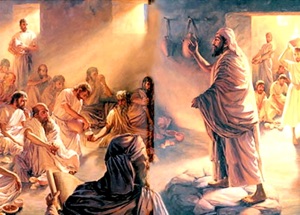 Depicted, Egyptian Nazarene Essenes at Qumran
Depicted, Egyptian Nazarene Essenes at Qumran

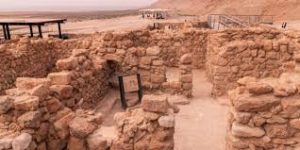
The surrounding area near Qumran is arid but contains many springs.
ENOCHIAN
The Enochian adherent believed there would be an end time and everyone must be prepared. The Nazarenes and the Ossaeans held a similar belief. The idea of a designated group, including those who join them, is indicated or stated throughout the Book of Enoch.
The Enochians believed a Messiah would be needed to administer the final teachings of the Law and the Prophets. Enoch chapters 38–40: “The first is the merciful, the patient, the holy Michael,” 40.8. The Enochian spiritual emphasis would be the Book of Enoch (Enoch), but otherwise very little is known about them.
However, the text of Enoch became a continued influence within the Hebrew Bible and probably has much to do with the Enochian sect’s viability. Also, the Book of Enoch is represented in the New Testament. Revelations 1.13-14 references the Ancient of Days, “His head and his hairs were like wool, as white as snow,” with Enoch’s 46.1-3, “…whose head was like white wool.”
Enoch 48.2-5, “In that hour the Son of man invoked before the Lord of spirits, and his name in the presence of the Ancient of Days. Before the sun and the signs were created, before the stars of heaven were formed, his name was invoked,” compared with John 1.1-2, “In the beginning was the Word, and the Word was with God, and the Word was God. The same was in the beginning with God.” Both scriptures would lead one to believe that the disciple John must have had familiarity with Enochic beliefs, even though both were many generations removed from Enoch.
The above scriptures require time, acceptance, refinement, and a continued and organized effort that forms an extended theology. This would infer the Enochic vision as ongoing, a root of Judaism almost from the beginning, perhaps as early as the times of Enoch himself. What later is designated as the Zadokite Priesthood is thought to have its roots in earlier priesthoods, beginning with Aaron, Moses’ brother. The traditions observed within the books of Samuel indicate a true prophet led by the Spirit, for it is he who designates David. But earlier traditions show evidence as well, most prominently Melchizedek, the King of Salem, a priest-king; also, Brothers of the Righteous are mentioned in Enoch, also indicating much earlier priesthoods.
Isaiah 9.6 (c. 725 BC) is another good example of the continuation of messianic theology: “For unto us a child is born, a Son is given; and the government shall be upon his shoulder. And his name will be called Wonderful, Counselor, Mighty God, Everlasting Father, Prince of Peace.” This gives attribution to the longer-standing messianic vision, which is very much in line with Enochian and Essenic thinking generally.
All Essene would consider themselves the Sons of Zadok, or Zadokites. “The Priests are the converts of Israel who departed from the land of Judah, and those (those of the Levitical priesthood) who joined them. The Sons of Zadok are the elect of Israel, the men called by name who shall stand at the end of days…” from the Damascus Document IV, Dead Sea Scrolls (also taken from Ezekiel 44.15-17). The Sons of Zadok were considered the most knowledgeable of the Zadokite priesthood.
§
OSSAEANS (Ossuary)/ NAZARENES (Nazara-sprout (branch)
The Qumran Essenes are known as the Ossaeans. The establishment of Qumran (Q’um Ran) is believed to have originated in 150 BC.
The later separation within the body of the Essene will represent two groups: those whose bent became legalist (Ossaeans) and those whose teachings remained uncluttered by the legalistic approach, later described as spiritual or enlightened (Nazarenes). As Jesus will demonstrate, the spirit of the law is more important than the written law itself. Early members of the Jesus faction were usually referred to as Nazaoreans, or those who practice in the Way.
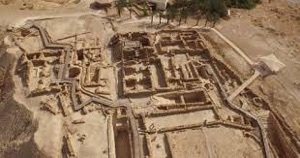 Osseaens would consider themselves the holiest of the Zadokite priesthood. They maintained strict adherence to Mosaic law but also created other laws in an attempt to make one even more holy. These holiness laws focus mainly on the Sabbath. They seem to have a penchant for using the mikvah often, and this is noted by many. Jesus the Nazarene would condemn these new laws in Matt. 15.1-15, “Teaching for doctrines the commandments of men,” (9).
Osseaens would consider themselves the holiest of the Zadokite priesthood. They maintained strict adherence to Mosaic law but also created other laws in an attempt to make one even more holy. These holiness laws focus mainly on the Sabbath. They seem to have a penchant for using the mikvah often, and this is noted by many. Jesus the Nazarene would condemn these new laws in Matt. 15.1-15, “Teaching for doctrines the commandments of men,” (9).
Many varied groups would have visited Qumran, in part due to the availability of manuscripts.
Ossaeans are generally identified with lawyers and scribes. They would maintain what is known today as the Scribal Authority. Many did have a deeper knowledge base, the problem is they interpreted from a legalistic approach, and they seemed not to want to share with the people the more intricate or secret knowledge they had assumed. Jesus would teach metaphysical truth, of which sowing the good seed is one; love prospers new growth and harmony while revenge does not, is another; and spiritual light brought into a room (mind) reveals all things. The core of Jesus’ teachings is metaphysical, often related to a more mystical pathway. So above (spirit), so below (earth) might describe Jesus’ message—or, the spirit brought down to the earth. The transference of the spirit into the physical, even that the kingdom is within, bodes a powerful reality the legalists could not grasp.
The law and only the law, might describe the position of the Scribal Authority.* One must remember that the original separation was due to the Temple priest’s corruption and Hellenistic syncretism. Certainly, they would believe, that the return to the basics, especially for priestly training, would reside in formalism and the formal study and application of the law. Since Ezra, the scribes had continued to gain influence and were later taken as the highest authority within Judaism, and just as certainly they would believe they should lead the way back from syncretism into holiness and purity.
Essene=scribes/lawyers, Kegel Companion Bible.
The Qumran priests and scribes considered their main task to copy, or multiply, scriptures. Scribes would be very well-versed in the law, and the lawyers themselves would be higher-ranking priests who would provide commentary. It is within this legal formalism the Scribal Authority emerges, later developing into a legitimate sect (scribes), designated as the Essene. The formalism of Ezra’s Second Temple’s legal sway contends with what would later become the Nazarene theology.
 Jesus chastizes Pharisees and lawyers.
Jesus chastizes Pharisees and lawyers.
The more extreme legalism would flow from the Ossaean, including non-scriptural cleansing practices, thus Pharisees would be much more closely associated with the legalist Osseaen Essene. Within biblical scripture, Pharisees and scribes are found together. Jesus, as a Nazarene, would be forced to contend with both.
Qumran itself may have had members from many different splinter groups visit its scrolls. Texts of various kinds have been discovered in the caves of Qumran. Jesus almost certainly visited Qumran but this has never been confirmed. Most scholars believe John the Baptist did.
This odd mixture of strict adherence to legalism*, which predominates the Essene pathway, counterposed to the soaring and superlative understanding of Messiah, seems incongruent. A person might think that the legal prescription well followed would lead to the next level of revelation. This ascension from words to realization does not seem to have occurred, however. The extension into legalism does not fit well with Messiah and the messianic message, by whom the final interpretation of the Law and the Prophets was to be given. The Ossaean-Essene scribes believed this message would be a dissertation on the law, with a few advancements upon the law or higher level commentaries and the return of themselves to Temple control.
*The legalism was pursued through intellectualism, or the study of minute relationships between the laws. Although this study may not be unwarranted, it stayed fixed at this level.
From the Community Rule of the Dead Sea Scrolls, we have, “The Master shall instruct all the sons of light and shall teach them the nature of all the children of men according to the kind of spirit which they possess, the signs identifying their works in their lifetime, their visitation for chastisement, and the time of their reward.” The Community Rule sets a high standard, yet we also observe codified behavior that somehow leads us to this standard.
Jesus, in his turn, gives us Matt. 15.11, preceded by 15.8, “This people draweth nigh unto Me (God) with their mouth, and honors Me with their lips; but their heart* is far from me.” Scribes and Pharisees (15.1) are referred to in these scriptures. The impetus toward righteousness through rules rather than an emphasis on revelation seems shared with all Qumran attendees and their priesthood.
*Heart understanding, as opposed to a legal dissertation, seems the intent here.
The arrival of Messiah would be the focused Essene expectation. However, the order of events within the Ossaean pathway had become sullied and stifled. There seems very little support for Jesus from any of the priestly community, although later it is noted that some Pharisee priests did favor Jesus but were afraid to speak up (Jn. 12.32-33). The suppression of Jesus came from the top down and was almost complete.
How many priests from Qumran rallied to Jesus’ side? We do not know. We do know that many of the scribes stood against Jesus (Acts 4.4-7; 14-18); Lk. 22.2, “And the chief priests and scribes sought how they might kill him; for they feared the people”*; Lk. 22.66-67, completes the journey with, “And as soon as it was day, the elders of the people and the chief priests and the scribes came together, and led him into the council, saying (67) Art thou the Christ, tell us.”
*they feared the people might convert.
The Qumran Essenes shared one common view with all Essene—that Essene priests were the proper Temple authority and would eventually assume authority within the Temple. As a faction of the original Zadokite priesthood, they did have a rightful claim. In agreement with Jesus, they neither would continue animal sacrifice in the Temple (Jn. 2.16-17).* Nazarenes (Jesus) were not known to practice animal sacrifice at all.
*A sacrifice to Rome had to be given each day, which was particularly odious to all Jews.
Many Osseaeans lived relatively Spartan lives, although it is not certain if all priests lived in that manner. Jesus, once he was married, certainly did not live a Spartan life, and in fact, seemed to enjoy gatherings and dinners where wine was available (Lk. 7.33).* This cleanliness and rules version of holiness versus a more natural or everyday life became a serious issue—whether it is phylacteries on robes, or wiping the cup and whispering a prayer to consecrate the deed—Jesus was accused numerous times of not obeying various purity laws. In fact, Sabbath law he largely dismissed. He healed on the Sabbath, of all things!
*This pretty much kills the idea that Jesus was, or at least remained a Nazarite. See, Nazarite John.
Many of the elderly came to Qumran because their time was short and sanctity would be high on the list of their accomplishments. The burial sites near Qumran contain hundreds of men, but hundreds of women also, at a separate site. This would indicate celibacy for both men and women, at least at this location. Set in their ways and the firmness of the law, they generally removed themselves from society. Legalism increased. Nor would they accept immersion from John the Baptist, essentially to convert to the new revelation, and for that reason would be left out of God’s plan (Lk. 7.30*).
*Lk. 7.30: “But the Pharisees and lawyers rejected the counsel of God against themselves, being not baptized of him (J. the Baptist).”
Jesus and the Nazarenes, who were located in Galilee and east and northward, were not known to have ever participated in sacrifice, nor is Jesus noted to have practiced sacrifice himself. Scripture would surely have mentioned such an event. Jesus clearly understands that mercy (love) must be preeminent over sacrifice (Mt. 9.13) and is the closer (more correct) resolution God requires for atonement.
The love principle Jesus teaches accentuates the inner man (spirit-man) and thus thrusts the man before God instead of first judging the man by the law, requiring a whole new spiritual order, and inferring a new standard for humanity and humane treatment under the law. Jesus disdained the cleanliness practices of the Pharisees. Celibacy was not a known practice by Nazarene priests. By contrast, one might say the Qumran Essene became intellectual legalists, as opposed to interpreting the spirit of the law as Jesus did.
§
KEEPERS of the LIGHT and the WAY
All Essene would view themselves as Sons of Light, keepers of the ‘light of truth’. Later, the continuation of this theme in the New Testament,  as in “…but was sent to bear witness to that light, That was the true light which gives light to every man,” Jn. 1.8-9 –all lead to the basic Essenic vision of Messiah who is the light of God, shining forth in purity, which in their view should not be denied by or to any Jew. “… true light which gives light to every man,” denotes that not only would Messiah reveal God in a manner not yet known to the Jews—“the true light”—but in doing so would become evident to others outside Judaism—”every man”. Those who could not recognize Messiah, those who thought otherwise, would become usurpers of one kind or another.
as in “…but was sent to bear witness to that light, That was the true light which gives light to every man,” Jn. 1.8-9 –all lead to the basic Essenic vision of Messiah who is the light of God, shining forth in purity, which in their view should not be denied by or to any Jew. “… true light which gives light to every man,” denotes that not only would Messiah reveal God in a manner not yet known to the Jews—“the true light”—but in doing so would become evident to others outside Judaism—”every man”. Those who could not recognize Messiah, those who thought otherwise, would become usurpers of one kind or another.
The spirit of man is the candle of the Lord, Searching all the inward parts of the belly (Pv. 20.27)
The Community, as it is written, established its group around strictness in obedience to the law. As mentioned, they  would become the ‘lawyers’ who would write the commentaries, an effort to provide what they considered deeper clarity. By contrast, Nazarenes would interpret law much as Jesus did, by the nature of enlightened understanding, or by the effusion of the spirit of God.
would become the ‘lawyers’ who would write the commentaries, an effort to provide what they considered deeper clarity. By contrast, Nazarenes would interpret law much as Jesus did, by the nature of enlightened understanding, or by the effusion of the spirit of God.
“…but shall impart true knowledge and righteous judgment to those who have chosen the Way [unto God],”* would be the intent of both divisions of Essene—by the Nazarenes at the arrival of Messiah and the new revelation that would set men free, essentially what we know today as the “Good News,” and by the Ossaeans through more purity laws and strictness to the law. Is it righteous to do good on the sabbath (Matt. 12.10-14), or is it more important to obey the law, this is perhaps the best biblical example of the two differing mentalities.
*Dead Sea Scrolls, Community Rule IX
The Ossaean view pronounced legalism combined with purity rituals as the core of the Judaic reformation. Nazarene Essenes interpreted the theology of the Way described as much more mystical. A useful example of this more mystical understanding is the use of the term “Son of Man,” (Lk. 22.66-71).* Son of Man is understood as a proper name and a soul of heavenly origin, literally, a divine anointed one who had not yet been revealed. The Son of Man would embrace the greater enlightenment of grace (Noah) as preeminent, as Jesus teaches, and would give the final interpretation of the Law and the Prophets, the final teaching of the Way. Jesus would leave the law subjugated to forgiveness and mercy. For this and other reasons Jesus is observed to have had Nazarene Essene roots—he would personify the Essenic-messianic vision for man, both in his teaching and in his person, rather than a continued or expanded vision for the law.
*(67) “If you are the Christ, tell us.” But he (Jesus) said to them, ‘If I tell you, you will by no means believe, (68), and if I also ask you, you will by no means answer me or let me go. (69) Hereafter the Son of Man will sit on the right hand of the power of God.’ (70) Then they all said, “Are you then the Son of God (interchangeable with Son of Man)?” And he said to them, “You rightly say that I am.”
The far northern location of the Nazarenes is important. “Here toward the end of the first century AD, we have members of the family of Jesus residing at places significantly called Nazara (Sproutville) and Cochaba (Starville)… not far from the Greek cities of the Decapolis. If we accept the statement of Epiphanius… that Cochaba was in Batanea, then we should look for Nazara in the same district.”*
*Jeffrey Butz. The Secret Legacy of Jesus (quoting Schoenfield), chap. seven. Rochester, Vermont: Inner Traditions.
In line with the above description, most scholars now believe the lost years of Jesus were spent in retreat locations preparing for what would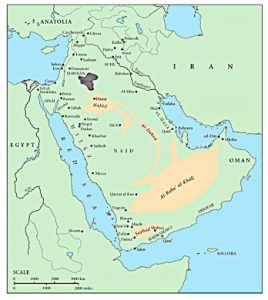 become his ministry work. It is almost certainly true that Jesus traveled, perhaps extensively, as this was a part of the priestly discipline. He may well have traveled to Damascus, much closer to the Hauron region (in gray) of Nazara and Cochaba than Jerusalem. That Saul later has letters of arrest to prosecute in Damascus tells us much about the widespread influence of the Nazarenes and the teaching called the Way. Jesus may have visited Qumran as well, for Jesus seems more than a little bit knowledgeable concerning the legalist Osseaens. Other foreign journeys may have included India and possibly northward into the Caspian. Alexandria and the southern reaches of the Nile (Elephantine) were known places of visitation and study.
become his ministry work. It is almost certainly true that Jesus traveled, perhaps extensively, as this was a part of the priestly discipline. He may well have traveled to Damascus, much closer to the Hauron region (in gray) of Nazara and Cochaba than Jerusalem. That Saul later has letters of arrest to prosecute in Damascus tells us much about the widespread influence of the Nazarenes and the teaching called the Way. Jesus may have visited Qumran as well, for Jesus seems more than a little bit knowledgeable concerning the legalist Osseaens. Other foreign journeys may have included India and possibly northward into the Caspian. Alexandria and the southern reaches of the Nile (Elephantine) were known places of visitation and study.
The enlightenment teaching of the Way would sound strange to those unfamiliar with Nazarene thinking. The Enochian and Nazarene Essenes held more visionary and mystical views, especially that a Messiah was necessary (not just arriving). It was believed that man could not sort the evils of this world, which only a heaven-sent being may do. As for the Sadducees, they did not see a need for Messiah, as they thought the Torah was complete and that man needed only to adhere to it.
In light of this difference, the scribal authority (lawyers & scribes) and the priestly authority (Sadducees & Pharisees) battered Jesus with philosophical and legal questions attempting to entrap him and thus either expose him to the Romans as a rabble-rouser, else turn the people against him. However, many ordinary citizens of the Essene sect, and some of the Pharisee adherents, did convert and believed Jesus to be the Messiah. Nicodemus, a ranking Pharisee and member of the Jerusalem Sanhedrin would be the most prominent example.
Sabbath law and practice had evolved in the previous two centuries, but not for the better. The disagreement with Jesus’ interpretation of the sabbath law became a concern. Sabbath observation, observing sanctity within this new legalism, soon becomes the conflict. Jesus presents a much more compassionate and revelatory view of life and the Sabbath,* yet at the same time practical.
*Jesus believed healing on the sabbath was holy; legalists believed carrying two figs was work and not allowed.
Revelatory, sometimes mystical but practical, describes the nature of the Way. Sowing seed is practical, speaking the Word is direct, and prayer is a mainstay. The fact that most of the Qumran Essene priests did not recognize their own Messiah leaves them in the legalistic basket with the Pharisees.
Most scholars agree that many of Jesus’ Galilean followers came from the Essene Community. Later, more Pharisaic followers would have joined the ranks. No one could deny what they saw, as healing and miracles became evident. To give one example of the expanding ministry: palm trees had never grown in Jerusalem, thus palm fronds laid before Jesus at the Eastern Gate had to come from Jericho; this effort would require organization and a knowledgeable commitment to assemble such a welcome. Even so, for his perceived blasphemies, the Essene scribes and lawyers continued a dark outlook on Jesus. Near the end of Jesus’ ministry, at least some of the Essene priesthood were vehemently against Jesus and are thought to have played a role in pressing for his crucifixion.
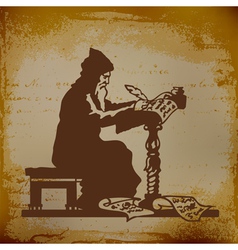
God Bless!
Loved this commentary! I learned a great deal. I’ve just recently started studying the Essences Q scrolls and you’ve added a great deal more.
Just, concerning the Damascus document; is this city different than the one in Syria?
Not clear as to your question, but thanks for the compliment. I upgrade articles from time to time, always looking for accuracy, clarity.
Damascus: Would have been considered capitol city for the Nazarenes. Paul went from Damascus into Arabia, and then returned to Damasacus before beginning ministry. Paul spent seven years in Arabia (Cochaba, Nazara, Damascus) receiving his priestly training. This training would have been similar to other priests, but it seems clear Paul had delivered unto him a special calling of the Holy Spirit. Paul would have taught what he had been taught, which provides for a messianic being, noted as Messiah and heaven sent.
Great article! Though I would note a few corrections I think are necessary. The first major point is that it is errenous to suppose the Qumran group must have been Essenes, and if they were, which is indeed possible, it would be a greater error to gather their identity by the books in their library. What we know for sure about the essenes from the references that can be found in original sources from the first few centuries CE, is that the Essenes in total were against the Jerusalem second temple cult of blood sacrifice, and that what distinguished the Essenes from the Nazarenes was primarily that they were celibate. Jesus would have began his life as part of a Nazarene community but in his training and ministry was further set apart and continued celibate as the other Essenes. All these groups represented the “root of Jesse” and stood for the religion of Old Israel before the reforms of Josiah and usurpation by the false Babylonian priesthood and the second temple blood cult. Old Israel was based on Lady Wisdom and the temple cult had no blood offerings, and these “root of Jesse” communities claimed that blood sacrifice was not given in the Law by Moses.
Thank you JDB, good addition to the Essene article. The Essene separation (150 BC) continued into Jesus’ time, providing a greater spiritual tension. By the times of Jesus, the attention to the law was ascendant (scribes, Pharisees, Sadducees, lawyers, many Essene priests). The law, and thus the religion had to be reformed (Jesus, Nazarenes, probably Enochians and other splinter groups). As to the law, Jesus expounded on what had become severity, condemnations without compassion (broadly speaking), Jn. 8.1-10, as an example. Most of Jesus’confrontations came from scribes, readily available in Jerusalem, from Qumran. “books in their library”, since they were scribes (copiers of manuscripts) they would naturally copy more requested manuscripts, such as Isaiah. It is not their books that are in question, but by removing the ‘spirit of the law’ and maintaining a firm legalistic view, the only spiritual pathway becomes reduced to the legal quest; thus not to quest after the Spirit, or God Himself. This structure of thought provides for no further growth within Judaism, only the better obeying of the law, if possible. The roots of the Qumran vision had fallen into a legal redundancy. All Essene were against the usurping Sadducees and their control of the Temple. But the new revelation to remove them could never come from various legal or power moves, as the Sadducees themselves were the legal authority (Great Sanhedrin).
Do not be so sure that Jesus continued within celibacy. “Wife’ and ‘Companion’ are synonymous, many scholars accept this word study as the correct interpretation. Also, even though a celibate Essene priest might begin ministry, he would never be accompanied by women, and certainly not a ‘strange’ or ‘loose’ woman, as those terms were used in that day. Also, the Qumran priests were generally older, and certainly had been married and had children. It was a very different matter for a priest of any kind to be giving counsel concerning wife, children, or household matters, had he never been married. This would not be acceptable, and Jesus would have been confronted on this matter, especially by those resisting his advice or teaching. Traveling with a ‘strange’ woman was allowed by no one.
The “root of Jesse” is the most important factor. The Nazarenes considered themselves that root, but did not consider the Essene legalists in the same manner. The “root of Jesse” was about to correct the imbalance upon law into balance within God. Thank you for mentioning the Babylonian Temple, which was largely orchestrated through Ezra, the highest-ranking scribe and was also a priest. Most scholars agree Ezra was heavy on Torah but perhaps left the spiritual attribution wanting.
‘Jesus the Nazarene’ gives more information relative to Jesus’ ministry.
Do you think it plausible that the Essene way of life as described by Philo was influenced somewhat by Pythagorus … prior to Hellenization by Alexander the Great?
No.
Philo: (79) “disorder by scheming covetousness,” read Cain, concerning weights and measures. Everything changes when Cain introduces them. Therefore, removal from such ‘devices’ would be a long-standing retreat practice and mentality when considering seeking God.
Philo: (83) Choosing right from wrong…” the love of God, the love of virtue, the love of mankind,” a central theme of Jesus’ teachings.
This viewpoint of God-Virtue-Mankind would be longstanding also, expressed by Enosh, Enoch, and Noah, all with various strengths displaying these virtues.
Essanoi were more specifically Nazoreans, which separates them from Osseaens, who were generally described as legalists, and scribes.
Pythagoras: Nazarenes all married and considered Osseaen celibacy misguided and a rude treatment of women, who would be exalted by marriage (increasing spiritual beauty?).
The article Nazarite John concerns Nazarite tradition, as well as removing oneself by the cutting of their hair.
The length of time (550 BC to 50 BC) would not seem to be helpful to the argument. Probably P. and Jesus had training from the same or similar traditional schools, that is possible, maybe probable. But as to beginnings, I would look to Samuel as the first forthright example, at least in the more modern biblical era; leading then to the Zadokite priesthood. It is from this point onward that I believe the secret schools and teachings began to make
themselves more obvious. David settled Saul’s sin perpetrated against the Giv’on. David later has to settle his own sin through humility and forgiveness– in other words, many of these teachings were moving through perhaps a greater current, one stretching from India to Egypt.
I hope this helps, but your question can lead in different directions. My support leans toward more modern, or perhaps codified roots, as we see in the Dead Sea Scrolls, mainly because this website stays focused on the values and teaching of the Way. Each article is written in that context even if historical.
As to the mystical: When you sow good seed you reach from the present into the future (see, Lazarus, Rending the Veil).
Good question, many trails.
Wow, fantastic blog format! How lengthy have you ever been running a blog for?
you made running a blog glance easy. The entire glance
of your website is fantastic, let alone the content material!